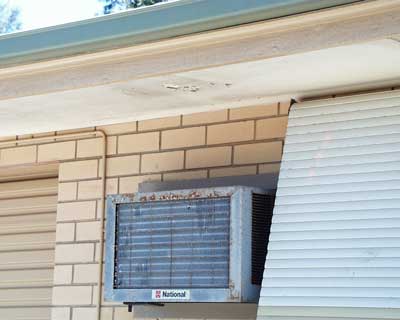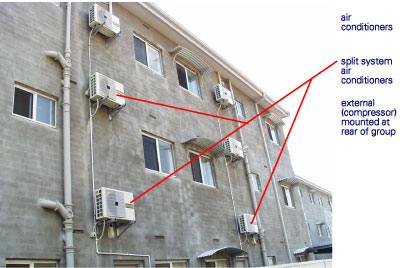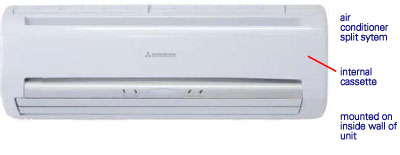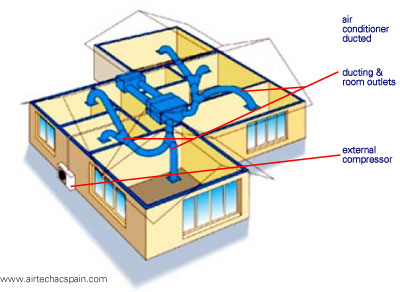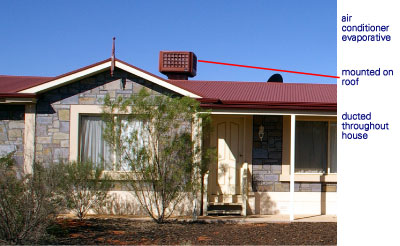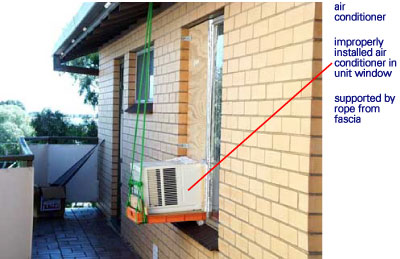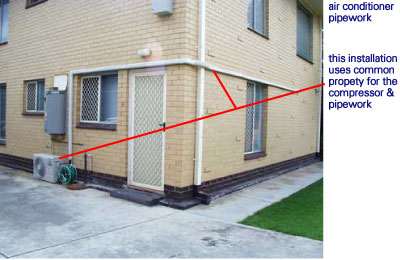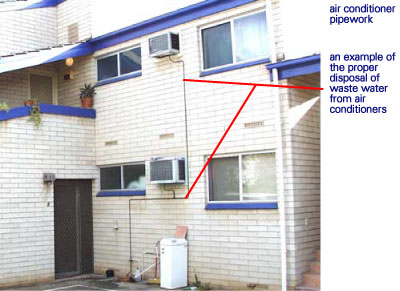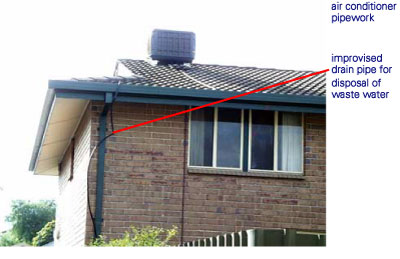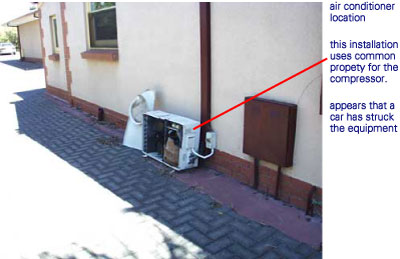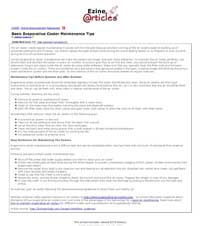Maintenance: Air Conditioners
Strata Titles Act (plan number less than 20,000)
Airconditioners: Section 5 part 6 of the Strata Titles Act goes on to spell out other structures and services that are the Strata Corporation’s responsibility to maintain.
Section 5: Boundaries
(6) The common property comprises:
(b) any pipe, cable, wire, duct or drain that is not for the exclusive use of a unit;
Section 25. The functions of the strata corporation are as follows:
(a) to administer and maintain the common property for the benefit of the unit holders and, to such extent as may be appropriate, other members of the strata community; and
(b) to administer all other property of the corporation
What does this mean?
If an air conditioner serves more than one unit it is common property. If it only serves one unit then it is the unit owner’s to maintain
Community Titles Act
If an airconditioner serves more than 1 unit/lot it is considered to be common property under Section 28 of the Act. Section 75 explains the Corporations responsibility to maintain the airconditioner.
Section 28—Common property
(1) The common property created by a community plan comprises—
(b) the service infrastructure (except for any part of the service infrastructure that is vested in a Minister of the Crown or other authority or person and the parts of the service infrastructure that provide a service to only one lot)
Section 3—Interpretation (1) In this Act, unless the contrary intention appears:
service infrastructure means cables, wires, pipes, sewers, drains, ducts, plant and equipment by which lots or common property are provided with—
(a) water reticulation or supply; or
(b) gas reticulation or supply; or
(c) electricity supply; or
(d) heating oil; or
(e) air conditioning or ventilation; or
(f) a telephone service; or
(g) a radio service; or
(h) a computer data or television service; or
(i) sewer systems; or
(j) drainage; or
(k) systems for the removal or disposal of garbage or waste; or
(l) other systems or services designed to improve the amenity, or enhance the enjoyment, of the lots or common property;
75—Functions and powers of corporations
(1) The functions of a corporation are
(a) to administer, manage and control the common property for the benefit of the owners of the community lots; and
(b) to maintain the common property and the property of the corporation in good order and condition
What does this mean?
The community corporation owns an airconditioner that is shared between units.
STRATA GLOSSARY
“allotment” means the whole of the land comprised in a certificate of title;
“building” includes a fixed structure;
“ceiling” includes a false or suspended ceiling;
“the Commission” means the Development Assessment Commission constituted under the Development Act 1993;
(a) in relation to a local government area—a municipal or district council;
(b) in relation to the parts of the State that lie outside local government areas—the Outback Areas Community Development Trust;
“the Court” means the Supreme Court of South Australia;
“deposited” in relation to a strata plan means deposited in the Lands Titles Registration Office by the Registrar-General;
“easement” includes a right of way;
(a) a life estate or a lease; or
(b) a mortgage or charge; or
(c) a claim or lien; or
(d) an easement; or
(e) a caveat;
“floor” includes a stairway or ramp;
“occupier” in relation to a unit means a person who occupies the unit on a temporary or permanent basis (either solely or jointly with other persons) and includes a person who is unlawfully in occupation of a unit;
“original registered proprietor” in relation to a strata scheme means the person who was, immediately before the deposit of the strata plan, the registered proprietor of an estate in fee simple in the land;
“owner” in relation to land means the proprietor of an estate in fee simple in the land;
(a) land vested in a council;
(b) land controlled or managed by a council;
“registered encumbrance” means an encumbrance registered or entered on a certificate of title;
“site” means the land comprised in a strata plan (as distinct from the buildings and other improvements to that land);
“special resolution” in relation to a strata corporation means a resolution as to which the following conditions are satisfied;
(a) at least 14 days’ written notice, setting out the terms of the proposed resolution, is given to the
unit holders;
(b) the resolution is supported at a duly convened general meeting of the strata corporation by a number of votes equal to, or exceeding, two-thirds of the total number of votes that could be exercised at a general meeting of the corporation assuming that all unit holders attended and exercised their right to vote;
“statutory encumbrance” means— (a) an agreement relating to the management, preservation or conservation of land lodged under Part 5 of the Development Act 1993; (b) any agreement or proclamation registered or noted on the title immediately before the commencement of the Development Act 1993 that is continued in force by virtue of the provisions of the Statutes Repeal and Amendment (Development) Act 1993;
“the strata community” means those who reside or work at the units in a strata scheme;
“strata corporation” means a body corporate created under this Act on the deposit of a strata plan;
“strata scheme” means—
(a) the land comprised in a strata plan; and
(b) the buildings and other improvements on that land;
“unanimous resolution” in relation to a strata corporation means a special resolution passed without any dissentient vote at a general meeting of the corporation;
“unit” means an area shown on a strata plan as a unit;
“unit holder” means—
(a) a person registered as proprietor of an estate in fee simple in the unit;
(b) if the fee simple is divided into a life estate with a remainder or reversionary interest—the person registered as the proprietor of the life estate;
“wall” includes a door or window.
COMMUNITY TITLE GLOSSARY
“allotment” means land registered under the Real Property Act 1886 that comprises an allotment defined by Part 19AB of that Act;
“annual general meeting” means a general meeting of a community corporation that is held in compliance with Section 82 of the Community Titles Act
“associate“-see Section 4 of the Community Titles Act
“by-laws“-see Section 34 of the Community Titles Act
“building” includes a fixed structure;
“ceiling” includes a false or suspended ceiling;
“community corporation” means a corporation established when a plan of community division is deposited in the Lands Titles Registration Office;
“community lot“-see Section 6 of the Community Titles Act
“community parcel” means the land divided by a plan of community division but does not include a street, road, thoroughfare, reserve or other similar open space vested in a council or prescribed authority or that has reverted to the Crown;
“community plan“-see “plan of community division”;
“community scheme“-see “scheme of community division”;
“council” means a municipal council or a district council;
“deposited” in relation to a plan of community division means deposited in the Lands Titles Registration Office by the Registrar-General;
“developer” in relation to a community scheme means the person who was the registered proprietor of the land comprising the community parcel immediately before the plan of community division was deposited in the Lands Titles Registration Office;
“development lot“-see section 8;
(a) a life estate or a lease;
(b) a mortgage or charge;
(c) a claim or lien;
(d) an easement;
(e) a caveat;
(f) a statutory encumbrance;
“floor” includes a stairway or ramp;
“land valuer” means a person who lawfully carries on a business that consists of or involves valuing land;
“leaseback arrangement“-see subsection (7);
“lot” means a community lot or a development lot;
“lot entitlement“-see section 20;
“lot subsidiary“-see section 19(3)(d);
“non-recurrent” in relation to expenditure means expenditure for a particular purpose that is normally made less frequently than once a year;
“occupier” in relation to a lot means a person who occupies the lot on a temporary or permanent basis (either solely or jointly with other persons) and includes a person who is unlawfully in occupation of a lot;
“ordinary resolution” of a community corporation means a resolution passed at a properly convened meeting of the corporation by a simple majority of the votes of members present and voting on the resolution;
(a) in relation to land (excluding a lot) means a person who is registered as the proprietor of an estate in fee simple in the land or, where a mortgagee is in possession of the land, means the mortgagee to the exclusion of the registered proprietor of the land;
(b) in relation to a lot (other than a lot referred to in paragraph (c)) means-
(i) a person who is registered as the proprietor of an estate in fee simple in the lot; or
(ii) if the fee simple is divided into a life estate with a remainder or reversionary interest-the person registered as the proprietor of the life estate to the exclusion of the proprietor of the remainder or reversionary interest; or
(iii) if a mortgagee is in possession of the lot-the mortgagee to the exclusion of the persons referred to in subparagraphs (i) and (ii);
(c) in relation to a primary or secondary lot that has been divided by a secondary or tertiary plan, means the secondary or tertiary corporation established on deposit of the plan in the Lands Titles Registration Office;
“plan of community division” or “community plan” means a plan that divides land into lots and common property;
“primary by-laws” means by-laws made under this Act in relation to the division of land by a primary plan of community division;
“primary community corporation” or “primary corporation” means the community corporation established on the deposit of a primary plan of community division in the Lands Titles Registration Office;
“primary lot“-see Section 7(1) of the Community Titles Act
“primary parcel” means land divided by a primary plan of community division but does not include a street, road, thoroughfare, reserve or other similar open space vested in a council or prescribed authority or that has reverted to the Crown;
“primary plan of community division” or “primary plan” means a plan of community division that divides land comprising an allotment;
“primary scheme” means a scheme of community division in which an allotment is divided into common property and primary lots;
“recurrent” in relation to expenditure means expenditure for a particular purpose that is normally made every year or more frequently;
“registered encumbrance” means an encumbrance registered or entered on the certificate of title for the land to which it relates;
“relative” in relation to a person, means the spouse (whether legal or putative) parent or remoter lineal ancestor, son, daughter or remoter issue or brother or sister of the person;
“relevant development authority” in relation to the division or other development of land means the person or body authorised by the Development Act 1993 to consent to, or approve of, the division or other development of the land or to give any other development authorisation under that Act in relation to the division or other development of the land;
“residential purposes” in relation to the use of land does not include the use of land for the purposes of a hotel, motel or hostel or to provide any other form of temporary residential accommodation for valuable consideration;
“schedule of lot entitlements” means the schedule of lot entitlements included in a plan of community division;
“scheme of community division” or “community scheme” in relation to land means the scheme for the division, development and administration of the land set out in the scheme description (if any), plan of community division, by-laws and development contract (if any) lodged with the Registrar?General under this Act in relation to the land;
“scheme description” means the description of the community scheme filed with the plan of community division deposited in the Lands Titles Registration Office; (applies to groups of 7 and more lots)
“secondary community corporation” or “secondary corporation” means the community corporation established on the deposit of a secondary plan of community division in the Lands Titles Registration Office;
“secondary lot“-see Section 7(2) of the Community Titles Act
“secondary parcel” means land divided by a secondary plan of community division but does not include a street, road, thoroughfare, reserve or other similar open space vested in a council or prescribed authority or that has reverted to the Crown;
“secondary plan of community division” or “secondary plan” means a plan of community division that divides land comprising a primary lot;
“secondary scheme” means a scheme of community division in which a primary lot is divided into common property and secondary lots;
“service infrastructure” means cables, wires, pipes, sewers, drains, ducts, plant and equipment by which lots or common property are provided with-
(a) water reticulation or supply; or
(b) gas reticulation or supply; or
(c) electricity supply; or
(d) heating oil; or
(e) air conditioning or ventilation; or
(f) a telephone service; or
(g) a radio service; or
(h) a computer data or television service; or
(i) sewer systems; or
(j) drainage; or
(k) systems for the removal or disposal of garbage or waste; or
(l) other systems or services designed to improve the amenity, or enhance the enjoyment, of the lots or common property;
“special resolution” of a community corporation means-
(a) where the number of community lots is three-see section 88;
(b) in all other cases-a resolution-
(i) of which at least 14 days notice setting out the text of the proposed resolution has been served on all the owners of the community lots; and
(ii) that is passed at a properly convened meeting of the corporation at which the number of votes (if any) cast against the resolution is 25 per cent or less of the total number of votes that could be cast at a meeting at which all members are present and entitled to vote;
“statutory encumbrance” means-
(a) an Aboriginal heritage agreement entered into under the Aboriginal Heritage Act 1988;
(b) an agreement relating to the management, preservation or conservation of land lodged under Part 5 of the Development Act 1993;
(c) any agreement or proclamation registered or noted on the title to land immediately before the commencement of the Development Act 1993 that is continued in force by virtue of the provisions of the Statutes Repeal and Amendment (Development) Act 1993;(d) a heritage agreement entered into under the Heritage Act 1993;
(e) a heritage agreement entered into under the Native Vegetation Act 1991;
(f) any other encumbrance created by statute and prescribed by the regulations for the purposes of this definition;
“strata lot” means a community lot created by a strata plan;
“strata plan“-see section 9 Strata division…….
(1) A plan of community division (to be called a “strata plan”) may create community lots with defined upper and lower boundaries as well as lateral boundaries.
(2) Each strata lot must be wholly or partly within a building that has been erected on the community parcel and the boundaries of the lots, or parts of the lots, that are within the building must be defined by reference to the building.
“strata scheme” means a scheme of community division under which land is divided by a strata plan;
“tertiary community corporation” or “tertiary corporation” means the community corporation established on the deposit of a tertiary plan of community division in the Lands Titles Registration Office;
“tertiary lot“-see section 7…….
(3) A secondary lot created by a secondary plan of community division under subsection (2) may be divided into two or more community lots (“tertiary lots”) and common property by a tertiary plan of community division.
“tertiary parcel” means land divided by a tertiary plan of community division but does not include a street, road, thoroughfare, reserve or other similar open space vested in a council or prescribed authority or that has reverted to the Crown;
“tertiary plan of community division” or “tertiary plan” means a plan of community division that divides land comprising a secondary lot;
“tertiary scheme” means a scheme of community division in which a secondary lot is divided into common property and tertiary lots;
“unanimous resolution” of a community corporation means a resolution-
(a) of which at least 14 days notice setting out the text of the proposed resolution has been served on all the owners of the community lots; and
(b) that is passed at a properly convened meeting of the corporation without any vote being cast against it;


